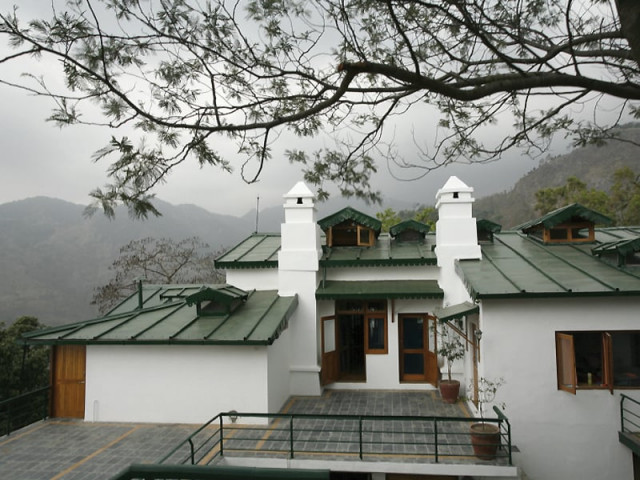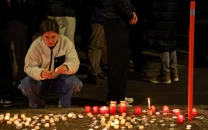The road less travelled
The author goes to India, and finds a hidden sanctuary away from the hustle and bustle of urban Delhi.

The road less travelled
Before work could begin, two days after I landed in Delhi, Geetan and I jumped into her red four-wheel-drive with destination Gethia on our minds. As I left the capital city, I had no sense of what was to come ahead.
While Delhi is historic, rich in culture and lush with foliage, it is also continually being reshaped, its bowels distending, rending, to reveal new bridges, buildings and subways. In the city, shopping malls and subway stations stand beside colonial architecture. The pace of development was more obvious in the outskirts as the haze of pollution from too many cars cleared from the midday sun to expose the scars and stains of progress in the shape of tenements, silos and factories. It looked like Karachi’s industrial area at first glance, but there was no Urdu script on the walls declaring political slogans, upcoming rallies or the ubiquitous deterrent to public urination in a country where there are no public toilets, “Dekho Kutta Paishaab Kar Raha Hai (Look, a dog is peeing here).” Squat mud houses in fragrant, yellow mustard fields replaced high-rise homes. I was reminded of the Grand Trunk Road cutting across Pakistan’s Punjab, but here, the steel structures expelling ribbons of grey into the sky were unrelenting for the first half of the five-hour car journey. The traffic was constant, consisting largely of trucks, the back of each reading two words, Horn Please, which is what they did incessantly, calling to mind a gaggle of honking geese.
Women in royal blue, fuchsia pink and acid green worked the fields; I noticed that they were not singing like they do in the movies. There was another commonality — while the women tilled, the men sat in lazy circles, playing cards and smoking beedi. It may have been familiar, but it was not particularly reassuring. And then, just as the Dev Anand CD came to an end and we slipped in Geeta Dutt, the poplar plantations came into sight. Human beings have a knack for debasing the most sublime things and the poplar tree exemplifies this. When I saw the rows of spindly trunks rising out of clouds of mist hovering over the wintry soil, bare branches as frail as whiffs of smoke against the setting sun, I could not imagine that these statuesque trees were used mostly for plywood and boxes for packaging.
A railroad crossing allowed us to stretch our legs. The crawling blue (not green like the ones at Karachi Cantt Station) train crammed with people made me lament the state of Pakistan Railways. I wondered at the seemingly inconceivable prospect of the Pakistan Railways shutting down; luckily a few days later, it pulled back from the edge of ruin to drag its tired old bogeys along.
The next hour was spent passing through more towns before we hit the forest reserve where the temperature dropped by ten degrees. All eyes were intent upon spotting the elusive leopard that at least one person in the car claimed to have seen. But the shimmering spots across us were those of a deer, and my gaze was locked with its shining eyes until the car swerved, and the animal leapt into the trees. The forest gave way to a winding road that revealed hills dotted with lights, a cluster of which at the highest point marked Nainital. Some distance below that, two warm yellow lights that are the beacons of Two Chimneys beckoned, making me sit at the edge of my seat in anticipation. I almost fell off it as we came face to face with a gigantic, garishly painted Hanuman placed incongruously in the midst of all that natural beauty by an ashram. To me, it didn’t seem very far from the Tariq Road roundabout and its centrepiece of a 20-foot-high, white, Pepsi-sponsored concrete monument that spells Allah — its hay pointing in a last flourish to one of the oldest and greenest graveyards in Karachi. However, both are dwarfed in comparison to the 120-foot-high Cristo Redentor statue in Rio de Janeiro. Ironically, the decidedly un-spiritual Pak-India border grows increasingly harder and much more militarised, and is now so brightly lit that it can be seen from space. The path we were on was, given the frequency of travel on it, remarkably smooth and flat, even if it was spiralling in a (to me) particularly stomach-churning way. Geetan quietly rolled down her window a sliver out of consideration for my susceptibility to carsickness, claiming she needed the fresh air. Given that it was a chilly six degrees, I recognised the little white lie, and my faith in humanity was restored. A few minutes later, it was positively revivified. For the moment that you see Two Chimneys, it fills you with a sense of the profound. It is the silence. Coming from the city, I’ll admit that my craving for quietude is in equal measure to my fear of it. It could go either way. Here, it embraced me, and unquestioning, I gave myself to it. It is the setting. At the edge of a cliff in the lower Himalayas, the property looks majestically down on valleys, slopes and steps cut out in mountains. The night sky was so thickly covered in stars that I could scarcely see the black; it was silver and aglow, shifting and expanding, pulling you in. Looking up at the constellations from a balcony at Two Chimneys, I had never been more acutely aware of my physical self as in that moment while also longing more than ever to be lifted out of myself.
It is the space. The window walls draw you into the liquid gold warmth of gleaming wood floors, lights and log fires without breaking the thread that binds you to the mountains, the night. You become a microcosm of your surroundings as they evoke a similar interiority in you — though my inner self may not have been quite so serene — while making you want to open yourself to the potentiality of the outside. Meta-conversations come easier in Gethia. It is the story. If you have read Tarun Tejpal’s The Alchemy of Desire set in Two Chimneys, the story may precede the space for you, although the space is what greets you from the cover of the book. Unknowingly, I chose the Willow Suite for its loft, its wide windows that face the fountain below and the swimming pool above, its door that opens onto the deck and the skylight over the bed. Each of the seven rooms has a wonderful view and, what is more difficult to achieve, its own distinctive character.
I later discovered that my room was the one in which the author had created night after night of erotic pleasure between the character, Catherine and her lover, Gaj Singh. There is also the other ‘true’ story of the European woman who built the original structure and, apparently, inhabited it even in death. As the tale goes, resentful of the new occupants, she beset renovation and construction with various obstacles until her name was engraved on a wooden plaque — Mme Durel’s Lodge, 1899 — and hung over the entrance. Her proprietary rights established, the spirit was appeased. I can tell you that my sleep in the bed of Mme Durel/Catherine was filled with dream, and I awoke with a sense of restless urgency. And then there was the day. Geetan’s design of Two Chimneys with its decks, terraces, balconies, perches, levels, nooks, water bodies (swimming pool, fountain and pond), gardens and trees is ingenious. It reflects the landscape in its organic growth and preserves the integrity of the setting in ways that I did not immediately absorb — as layered as the place is — but discovered turn by turn, with every step I took. As the mountains took on ever-changing facades — splendid in sunbeam, shrouded in mist, rugged when overcast — so too did Two Chimneys offer itself anew in exploration.
All sections of Two Chimneys’ exterior are named — every name, each area worthy of comment. Watching the sun come up from the highest point, named the ‘Machaan’, the sky reddening, then paling, the silence filling with birdsong, a lone tractor ploughing the earth of the valley, the silver oak shimmering, true to its name, I felt overwhelmed. I was also inexplicably nostalgic — my ears searched for a familiar song, I was gripped by a longing for my parents, past and present loves drifted through my mind.
At the farthest point is ‘Land’s End’. I was told that during the monsoon months, you can see the mist rolling in as the bowl below fills to form a lake. On this winter’s day, I saw the young men of the town playing cricket. The words ‘Shabash, Shabash’ traveled up the mountainside much the same way they would have climed up the two floors of my seaside apartment back in Karachi. The front upper terrace named Charbagh has a fountain in its centre, a cosy sitting area and lush green trees — most planted personally by Geetan. Watching her plant a cluster of tomato saplings with tender yet strong hands, patting away at the soil with a kind of tough love, I was not surprised at how tall and firm those trees stand.
There are always levels at the lodge, and a few steps up from the terrace took me to an herb garden and a surface perfectly sized for two. The owners fondly refer to this nook as ‘Majnu ka Teela’ (Majnu’s Mound) for the pinkish light that slants across it at sunset, making it the perfect kissing spot. The counterpart of Charbagh at the opposing end is The Deck, a large terrace split in two with table settings, spectacular views of the mountains all around, a swimming pool running through it, and the sound of water falling from a fountain into a pond accentuating the serenity of the spot. In the day, this sound mingles with the chirping of birds and at night with the chirring of cicadas. The day flows into night and night into day at Two Chimneys, and I floated along for the two days and three nights that I was there. On the third morning as the sun was coming up over Gethia, Delhi and Karachi too, the sky bringing in the blue, the birds beginning to sing, Kishore Kumar writing letters of love, I breathed in great big gulps partly out of sentimentality for the clean air and in some part to keep the carsickness down as we made our way down the winding road back to the city.
Published in The Express Tribune, Sunday Magazine, April 1st, 2012.



















COMMENTS
Comments are moderated and generally will be posted if they are on-topic and not abusive.
For more information, please see our Comments FAQ